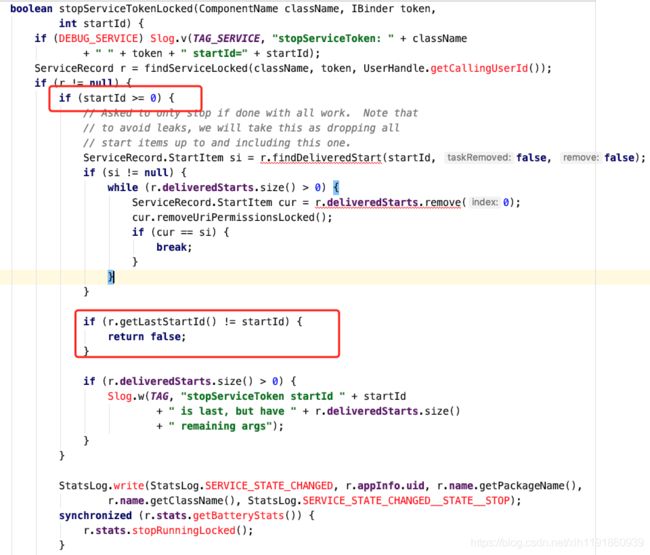从源码角度理解HandlerThread和IntentService
-
基础:需要对于消息机制的四大部分有一定了解,可以参考此篇。
-
HandlerThread.
public class HandlerThread extends Thread { int mPriority; int mTid = -1; Looper mLooper; private @Nullable Handler mHandler; public HandlerThread(String name) { super(name); mPriority = Process.THREAD_PRIORITY_DEFAULT; } public HandlerThread(String name, int priority) { super(name); mPriority = priority; } protected void onLooperPrepared() { } @Override public void run() { mTid = Process.myTid(); Looper.prepare(); synchronized (this) { mLooper = Looper.myLooper(); notifyAll(); } Process.setThreadPriority(mPriority); onLooperPrepared(); Looper.loop(); mTid = -1; } public Looper getLooper() { if (!isAlive()) { return null; } // If the thread has been started, wait until the looper has been created. synchronized (this) { while (isAlive() && mLooper == null) { try { wait(); } catch (InterruptedException e) { } } } return mLooper; } @NonNull public Handler getThreadHandler() { if (mHandler == null) { mHandler = new Handler(getLooper()); } return mHandler; } public boolean quit() { Looper looper = getLooper(); if (looper != null) { looper.quit(); return true; } return false; } public boolean quitSafely() { Looper looper = getLooper(); if (looper != null) { looper.quitSafely(); return true; } return false; } public int getThreadId() { return mTid; } }关于HandlerThread注意两点就好:
- 继承自Thread类,即是一个线程类
- 在run方法里,为当前线程指定了Looper对象,不需要使用者显示的调用Looper.prepare()以及Looper.loop()方法
-
IntentService
- 抽象类,在使用时需要继承该类,并且重写其中的 protected abstract void onHandleIntent(@Nullable Intent intent);
- 是一个服务类
由于是Service,所以我们需要关注其对应的几个生命周期方法的实现:
- onCreate()方法
@Override
public void onCreate() {
// TODO: It would be nice to have an option to hold a partial wakelock
// during processing, and to have a static startService(Context, Intent)
// method that would launch the service & hand off a wakelock.
super.onCreate();
HandlerThread thread = new HandlerThread("IntentService[" + mName + "]");
thread.start();
mServiceLooper = thread.getLooper();
mServiceHandler = new ServiceHandler(mServiceLooper);
}
private final class ServiceHandler extends Handler {
public ServiceHandler(Looper looper) {
super(looper);
}
@Override
public void handleMessage(Message msg) {
onHandleIntent((Intent)msg.obj);
stopSelf(msg.arg1);
}
}
一些初始化工作,创建了我们前面提到的HandlerThread对象以及ServiceHandler对象。
- onBind()方法
@Override
@Nullable
public IBinder onBind(Intent intent) {
return null;
}
没啥子逻辑,直接返回了null,也就意味着默认只支持start方式启动该IntentService。当然我们也可以重写该方法,让其支持bind方式启动从而实现相关功能。
- onStartCommand()方法
@Override
public int onStartCommand(@Nullable Intent intent, int flags, int startId) {
onStart(intent, startId);
return mRedelivery ? START_REDELIVER_INTENT : START_NOT_STICKY;
}
@Override
public void onStart(@Nullable Intent intent, int startId) {
Message msg = mServiceHandler.obtainMessage();
msg.arg1 = startId;
msg.obj = intent;
mServiceHandler.sendMessage(msg);
}
这块主要的逻辑就是通过ServiceHandler发送了一条Message,并在Message中携带了intent和startId。
- onDestroy()方法
@Override
public void onDestroy() {
mServiceLooper.quit();
}
让HandlerThread中对应的Looper退出。
最后,我们再关注下ServiceHandler的实现:
private final class ServiceHandler extends Handler {
public ServiceHandler(Looper looper) {
super(looper);
}
@Override
public void handleMessage(Message msg) {
onHandleIntent((Intent)msg.obj);
stopSelf(msg.arg1);
}
}
在handleMessage方法里:调用了抽象方法onHandleIntent(),并把Message中携带的Intent取出来,最后调用了stopSelf方法。
public final void stopSelf() {
stopSelf(-1);
}
/**
* Old version of {@link #stopSelfResult} that doesn't return a result.
*
* @see #stopSelfResult
*/
public final void stopSelf(int startId) {
if (mActivityManager == null) {
return;
}
try {
mActivityManager.stopServiceToken(
new ComponentName(this, mClassName), mToken, startId);
} catch (RemoteException ex) {
}
}
这俩方法的区别也就是startId的值不同,导致的效果就是:
startId = -1时,也就是调用不带参数的stopSelf方法,它会立即停止服务;stopSelft(int startId)则会等待所有的消息都处理完毕后才终止服务(也就是多次调用了startService()方法)
- 测试IntentService
class TestIntentService : IntentService("TestIntentService") {
override fun onCreate() {
super.onCreate()
Log.e(TAG, "onCreate():currentInstance = $this")
}
override fun onHandleIntent(intent: Intent?) {
val name = intent?.getStringExtra(NAME)
Log.e(TAG, "onHandleIntent -> $name, ${
Thread.currentThread()}")
SystemClock.sleep(3000)
}
override fun onDestroy() {
super.onDestroy()
Log.e(TAG, "onDestroy()..." )
}
companion object {
private const val NAME = "name"
private val TAG = TestIntentService::class.java.simpleName
fun start(context: Context, name: String) {
Intent(context, TestIntentService::class.java)
.putExtra(NAME, name)
.run {
context.startService(this) }
}
}
}
在MainActivity里:
class MainActivity : AppCompatActivity(), CoroutineScope by MainScope() {
override fun onCreate(savedInstanceState: Bundle?) {
super.onCreate(savedInstanceState)
setContentView(R.layout.activity_main)
launch {
repeat(3) {
delay(2000)
TestIntentService.start(this@MainActivity, "MainActivity-0$it")
}
}
}
}
每隔2s,启动一次Service;而在TestIntentService的onHandleIntent方法里,固定休眠了3s。这样最后的日志输出为:
onCreate():currentInstance = com.xlh.test.TestIntentService@7b7159c
onHandleIntent -> MainActivity-00, Thread[IntentService[TestIntentService],5,main]
onHandleIntent -> MainActivity-01, Thread[IntentService[TestIntentService],5,main]
onHandleIntent -> MainActivity-02, Thread[IntentService[TestIntentService],5,main]
onDestroy()…
现在我们改成每隔4s启动一次Service:
launch {
repeat(3) {
delay(4000)
TestIntentService.start(this@MainActivity, "MainActivity-0$it")
}
}
此时日志输出为:
onCreate():currentInstance = com.visionblue.haiyou.cd.TestIntentService@79a8a04
onHandleIntent -> MainActivity-00, Thread[IntentService[TestIntentService],5,main]
onDestroy()…
onCreate():currentInstance = com.visionblue.haiyou.cd.TestIntentService@7cd1a22
onHandleIntent -> MainActivity-01, Thread[IntentService[TestIntentService],5,main]
onDestroy()…
onCreate():currentInstance = com.visionblue.haiyou.cd.TestIntentService@6384270
onHandleIntent -> MainActivity-02, Thread[IntentService[TestIntentService],5,main]
onDestroy()…
对比两次的结果,我们可以得出结论:
- 对于client端来的请求,IntentService是顺序处理的
- 一个请求处理完毕,如果此时没有新的请求,那么IntentService会进行销毁;一个请求还在处理过程中,如果有新的请求,那么IntentService会在本次请求处理完成后接着去处理新的请求,此时不会销毁。待所有请求处理完毕后,再进行销毁
- onHandleIntent()在子线程中运行
- startId
要想理解这里的startId以及两个重载的stopSelf()方法,这块我们需要对Service的start方式的启动流程熟悉。我们这里只简单梳理一下:
Context.startService() -> ContextWrapper.startService() -> ContextImpl.startServiceCommon() -> ActivityManager.getService().startService() -> ActivityManagerService.startService() -> ActivityServices.startServiceLocked()
到这里我们就可以停一下了:
r.pendingStarts.add(new ServiceRecord.StartItem(r, false, r.makeNextStartId(),
service, neededGrants, callingUid))
这里的r就是ServiceRecord,我们来看其makeNextStartId()的实现:
public int makeNextStartId() {
lastStartId++;
if (lastStartId < 1) {
lastStartId = 1;
}
return lastStartId;
}
每start一次,startId就会自增1,而且从这里可以得知:startId >= 1。
如果要再往下分析的话:
ActivityServices.startServiceInnerLocked() -> ActivityServices.bringUpServiceLocked() -> ActivityServices.realStartServiceLocked()
在realStartServiceLocked()方法里:
app.thread.scheduleCreateService(r, r.serviceInfo,
mAm.compatibilityInfoForPackage(r.serviceInfo.applicationInfo),
app.getReportedProcState())
这行代码最终会导致Service对象的创建以及onCreate()生命周期方法的回调,具体实现可阅读ApplicationThread以及ActivityThread类源码。
sendServiceArgsLocked(r, execInFg, true); -> r.app.thread.scheduleServiceArgs(r, slice);
最终会导致onStartCommand的回调,从而将startId带了过去。至此,启动的流程我们就告一段落。我们接下来看stopSelf(int startId)的实现:
public final void stopSelf(int startId) {
if (mActivityManager == null) {
return;
}
try {
mActivityManager.stopServiceToken(
new ComponentName(this, mClassName), mToken, startId);
} catch (RemoteException ex) {
}
}
@Override
public boolean stopServiceToken(ComponentName className, IBinder token,
int startId) {
synchronized(this) {
return mServices.stopServiceTokenLocked(className, token, startId);
}
}
注意红框中的代码,如果startId大于0,而且当ServiceRecord中的lastStartId和传入startId不相等时,直接return回去,接下来的停止逻辑就没有执行了,只有相等时,才会继续往下走。
r.startRequested = false;
if (r.tracker != null) {
r.tracker.setStarted(false, mAm.mProcessStats.getMemFactorLocked(),
SystemClock.uptimeMillis());
}
r.callStart = false;
final long origId = Binder.clearCallingIdentity();
bringDownServiceIfNeededLocked(r, false, false);
Binder.restoreCallingIdentity(origId);
return true;
这就是下面的代码,重点就是bringDownServiceIfNeededLocked(),这里就不再往下分析了。实际上到这里,我们已经能够总结出stopSelf(int startId)的特点了:
- startId < 0:stopSelf()方法会直接停止Service
- startId > 0 && startId != ServiceRecord.lastStartId:不会停止Service,代码流程直接返回
- startId > 0 && startId == ServiceRecord.lastStartId: 直接停止Service。
如果我们此时再回头去看我们上面的示例代码时,一切就都了然于心了。

